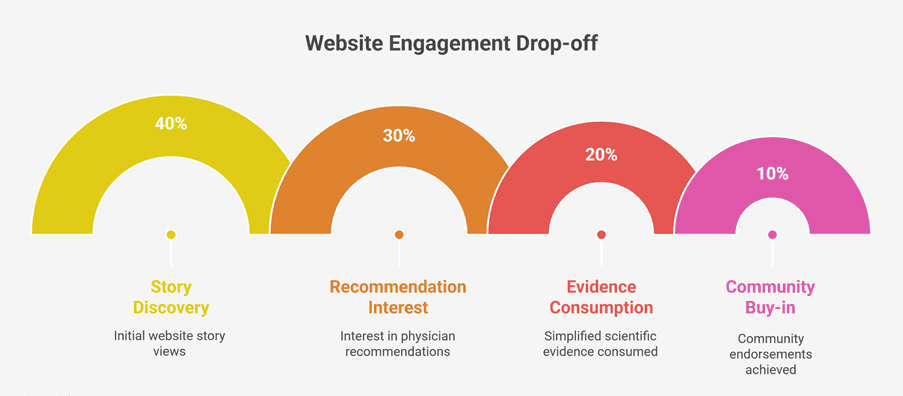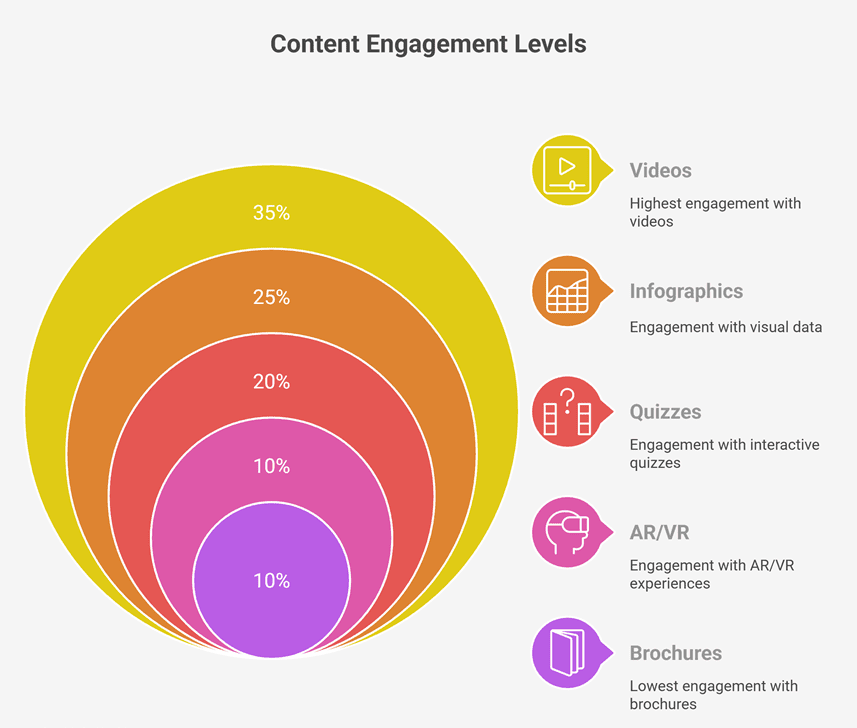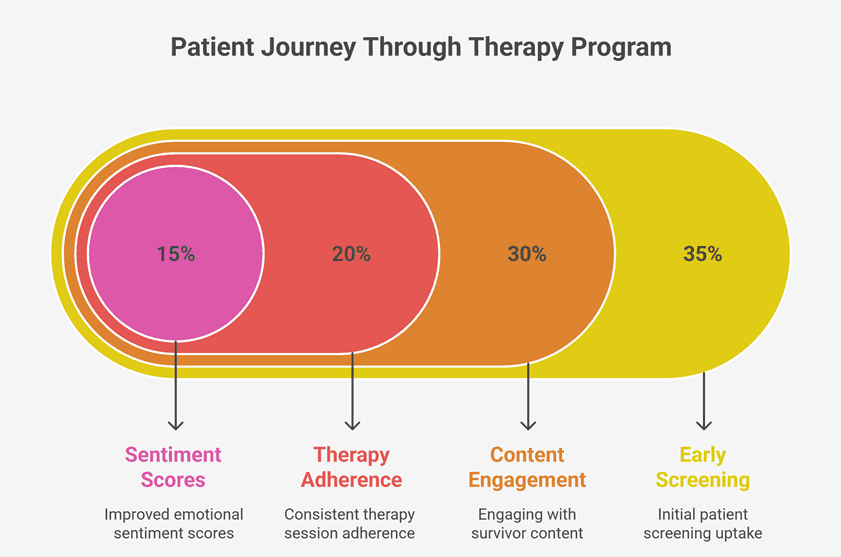Introduction: Why Science Needs Storytelling in Oncology Marketing
Oncology is one of the most complex and emotionally charged fields in healthcare. Scientific breakthroughs in immunotherapy, targeted therapies, and precision diagnostics have redefined treatment. Yet, for patients and caregivers, science alone often feels overwhelming.
Here lies the intersection of science and storytelling, where complex data is translated into human-centered narratives. Artificial Intelligence (AI) now bridges this gap by:
- Translating scientific language into empathetic patient stories.
- Personalizing content that aligns with patient journeys.
- Enabling pharma marketers to balance data-driven precision with emotional resonance.
This article explores how AI empowers oncology marketing campaigns that combine the rigor of science with the power of empathy, driving trust, access, and adoption.
1. The Shift from Data-Heavy to Emotionally Intelligent Campaigns
Traditional oncology campaigns emphasized trial results, efficacy percentages, and clinical jargon. Today, patients and caregivers seek humanized narratives.
AI transforms this shift by:
- Analyzing patient feedback and sentiment to shape empathetic messaging.
- Identifying what language patients trust most in awareness campaigns.
- Ensuring science is communicated without losing humanity.
Strategic Value: Campaigns resonate more deeply, improving patient understanding and physician engagement.
2. Science Meets Storytelling: The Role of AI in Narrative Building
AI assists in merging evidence with emotion:
- Using natural language processing (NLP) to mine survivor stories, testimonials, and clinical case notes.
- Identifying common themes (fear, resilience, stigma) across patient journeys.
- Crafting narratives that embed clinical accuracy while reflecting authentic experiences.
Outcome: Brands move from being product-centric to purpose-centric, creating stronger community connections.
3. Hyper-Personalization Through AI-Driven Storytelling
Oncology is not one-size-fits-all. AI allows marketers to design narratives for:
- Different cancer types (e.g., lung vs. breast vs. oral cancers).
- Life stages (early diagnosis vs. relapse vs. survivorship).
- Cultural contexts (urban English-speaking patients vs. rural vernacular audiences).
Example: A breast cancer awareness video for young women may emphasize early self-exams, while one for older women may highlight survivorship stories.
4. Storytelling That Builds Trust Among Physicians
Physicians balance scientific rigor with patient reassurance. AI enables:
- Summarizing clinical trial evidence into visual, narrative-driven toolkits for oncologists.
- Creating peer-sharing platforms where doctors contribute real-life case anecdotes.
- Aligning scientific storytelling with evidence-based trust building.
This ensures that physicians perceive pharma companies as partners in care rather than just promoters.
5. AI-Enhanced Patient-Caregiver Campaigns
Caregivers are often decision influencers. AI identifies caregiver pain points, financial stress, emotional fatigue, lack of information, and creates narratives that:
- Provide emotional support stories.
- Offer financial navigation resources.
- Share community-driven encouragement from other caregivers.
6. Using AI to Humanize Clinical Data
Statistics alone rarely inspire action. AI turns data into relatable storytelling:
- Translating “progression-free survival rates” into real-life extensions of time spent with family.
- Illustrating drug safety profiles with patient-first language.
- Embedding real-world outcomes into interactive stories patients can relate to.
7. AI and Survivor Voices in Campaigns
Survivors are the most authentic storytellers. AI helps amplify their voices by:
- Identifying regional survivor influencers.
- Matching survivor stories to specific patient demographics.
- Distributing these narratives through preferred digital channels (Reels, podcasts, vernacular radio).
Impact: Survivor-led campaigns drive higher engagement and trust compared to generic scientific ads.
Elements Driving Patient Trust in Oncology Campaigns
- Survivor Stories – 40%
- Physician Recommendations – 30%
- Scientific Evidence Simplified – 20%
- Community Endorsements – 10%

8. Emotional Intelligence in AI Storytelling
AI sentiment analysis reveals how audiences react to different tones:
- Fear-based messaging often causes avoidance behavior.
- Hope-driven narratives increase screening participation.
- Stories of resilience inspire adherence to therapy.
Marketers can continuously optimize content tone for maximum emotional impact.
9. Behavioral Science Meets AI in Oncology Marketing
AI integrates behavioral nudges into storytelling campaigns:
- Reminders tied to emotional cues (e.g., “a reminder for your loved ones”).
- Gamified symptom quizzes designed with empathetic narratives.
- Rewards for participation in screening camps framed as community achievements.
Outcome: Increased early detection rates and treatment adherence.
10. Omnichannel Storytelling Powered by AI
AI ensures consistent, empathetic narratives across platforms:
- Social media: bite-sized survivor stories.
- Apps: personalized treatment journeys.
- Webinars: combining clinical updates with emotional storytelling.
- Voice-first platforms: accessible narratives for low-literacy populations.
11. Storytelling for Rural and Vernacular Audiences
AI-driven vernacular campaigns humanize oncology messaging:
- Folk storytelling for oral cancer awareness in rural India.
- Localized survivor-led radio plays in regional dialects.
- Voice-based AI assistants delivering emotional counseling in local languages.
This ensures inclusivity and deep cultural resonance.
12. Aligning Scientific Storytelling with Payer Engagement
Payers need both science and empathy. AI enables:
- Translating outcomes into humanized cost-benefit stories (e.g., “therapy helps patients return to work sooner”).
- Embedding survivor narratives into payer discussions to justify reimbursement.
- Creating predictive storytelling models linking outcomes with cost savings.
13. AI in Visual Storytelling: Beyond Text
Oncology campaigns benefit from immersive storytelling formats powered by AI:
- AR/VR-based patient journeys visualizing therapy benefits.
- Data visualizations converted into emotional infographics.
- AI-generated animations simplifying complex mechanisms of action.
Result: Science is understood, remembered, and acted upon.

14. AI in Community-Led Storytelling Campaigns
AI strengthens local advocacy by:
- Mapping grassroots organizations aligned with oncology awareness.
- Identifying local champions who narrate authentic stories.
- Facilitating digital survivor clubs that share regional stories.
15. Ethical AI in Storytelling
Executives must guard against manipulative storytelling. AI-driven ethical frameworks ensure:
- Accuracy of scientific claims.
- Respect for cultural sensitivity.
- Avoidance of patient exploitation.
This protects brand reputation while building genuine trust.
16. Real-World Pharma Examples
- Novartis: Used AI-driven emotional storytelling in breast cancer campaigns across Europe.
- Roche: Combined genomic science with survivor narratives for lung cancer awareness.
- Pfizer: Developed AI chatbots that combine symptom triage with empathetic dialogue.
These cases highlight the practical success of science-meets-storytelling campaigns.
17. Measuring Impact: New KPIs in Empathetic Marketing
AI helps track value-driven outcomes rather than vanity metrics:
- % increase in early screenings.
- Engagement with survivor story content.
- Emotional sentiment scores across campaigns.
- Adherence rates tied to empathetic nudges.

18. Future of Science + Storytelling in Oncology
AI will drive the next era of oncology marketing by:
- Emotion-aware campaigns adapting to real-time patient moods.
- Digital twins simulating patient experiences for education.
- Immersive community ecosystems blending science and storytelling in shared digital spaces.
19. Advanced AI Techniques for Narrative Personalization
Beyond basic segmentation, advanced AI models use deep learning and contextual analysis to craft nuanced stories for oncology campaigns.
- Generative AI models create empathetic patient journeys tailored to treatment stages.
- Context-aware algorithms ensure content reflects not just medical needs but also emotional triggers.
- Predictive storytelling engines adjust narrative tone, optimistic, reassuring, or informative, based on user interaction history.
- Adaptive multimedia tools combine text, video, and voice in real-time for maximum emotional resonance.
Strategic Impact: Campaigns evolve dynamically, making each patient feel seen, understood, and supported.
20. AI in Global Oncology Storytelling
Cancer is universal, but narratives differ by geography and culture. AI ensures storytelling resonates globally:
- Asia-Pacific: Vernacular storytelling emphasizes community resilience and family strength.
- Europe: Scientific credibility combined with survivor voices drives trust.
- Africa: Storytelling blends with oral traditions, radio plays, and community leaders.
- North America: Digital-first strategies emphasize survivor-led videos and interactive content.
Outcome: Campaigns achieve global reach while respecting local emotional realities.
21. AI for Cross-Cultural Sensitivity in Oncology Narratives
Oncology marketing often fails when cultural nuances are ignored. AI solves this by:
- Detecting cultural taboos around cancer discussions (e.g., stigma in rural India).
- Recommending alternative storytelling styles (faith-driven, family-oriented, or youth-centric).
- Aligning survivor stories with cultural role models (teachers, mothers, community leaders).
- Ensuring translations are not just linguistic but emotionally accurate.
Leadership Advantage: Empathy-driven campaigns that cross cultural boundaries without missteps.
22. AI-Powered Storytelling for Early Detection Campaigns
One of oncology’s biggest challenges is late diagnosis. AI storytelling improves early detection by:
- Turning scientific screening guidelines into narrative nudges (“a simple test today may give you years with your family”).
- Deploying risk calculators with narrative explanations.
- Highlighting survivor stories where early screening saved lives.
Impact: Higher participation in screenings, especially in regions with cultural stigma around cancer.
23. Storytelling at the Point of Care
The clinical environment itself can be a storytelling channel. AI-powered solutions:
- Display emotional survivor stories in oncology waiting rooms.
- Deliver personalized educational videos on tablets and kiosks during consultations.
- Provide AI-generated infographics explaining treatment pathways in simple, patient-friendly terms.
This ensures storytelling is not just external but integrated into the treatment journey.
24. AI in Long-Term Survivor Engagement
Survivorship is often overlooked in oncology marketing. AI helps create sustainable, long-term narratives:
- Personalized survivorship plans delivered via mobile apps.
- Community forums moderated by AI to encourage safe, empathetic discussions.
- Monitoring survivor sentiment to adjust campaign tone and support.
- Encouraging survivors to become storytelling ambassadors.
Result: Survivors evolve into long-term brand advocates, fueling authentic empathy-driven marketing.
25. The Neuroscience of Storytelling Enhanced by AI
Neuroscience shows that stories activate brain regions linked to empathy. AI enhances this effect:
- Tracking eye movements and emotional responses to refine narratives.
- Identifying which scientific data points trigger emotional resonance.
- Predicting memory recall to ensure that messages stay with patients and caregivers.
Executive Insight: Campaigns achieve deeper emotional impact without sacrificing scientific accuracy.
26. Overcoming Digital Fatigue with AI Storytelling
Cancer patients and caregivers face digital overload. AI reduces fatigue by:
- Delivering bite-sized empathetic narratives.
- Optimizing frequency and tone to avoid message fatigue.
- Switching between formats (videos, podcasts, visuals) for variety.
- Detecting digital disengagement and adjusting outreach pace.
Outcome: Continuous engagement without overwhelming vulnerable audiences.
27. AI in Pharma Corporate Social Responsibility (CSR) Storytelling
CSR initiatives in oncology often lack visibility. AI-powered storytelling enhances impact by:
- Highlighting CSR activities (screening camps, education drives) through empathetic narratives.
- Tracking community sentiment towards CSR campaigns.
- Sharing real-world impact stories (families supported, screenings conducted).
C-Suite Value: CSR becomes not just philanthropy, but a strategic trust-building tool.
28. AI and Storytelling for Oncology Payer Negotiations
Payers are often swayed by scientific evidence plus human impact stories. AI strengthens negotiations by:
- Embedding patient testimonials into payer dossiers.
- Simulating future healthcare costs saved by early detection.
- Visualizing data through story-based infographics.
Result: Payers perceive therapies as both scientifically sound and socially valuable.
29. Chatbots as Storytelling Assistants
AI-powered chatbots now go beyond answering FAQs, they narrate empathetic micro-stories:
- Sharing survivor anecdotes in response to patient concerns.
- Guiding caregivers with narrative-based emotional support.
- Offering motivational stories during adherence reminders.
Advantage: A 24/7 empathetic companion, blending science and emotion.
30. Empathetic Storytelling in Oncology Awareness Months
Awareness campaigns (e.g., Breast Cancer Awareness Month) often risk becoming overly commercialized. AI ensures empathy by:
- Tracking sentiment to avoid perceived insensitivity.
- Highlighting genuine survivor and caregiver voices.
- Connecting scientific screening guidelines with emotion-driven stories.
Outcome: Authentic, emotionally resonant campaigns that build community trust.
Bar Chart: Barriers to Effective Oncology Storytelling
- Overuse of Scientific Jargon – 30%
- Lack of Survivor Voices – 25%
- Cultural Disconnect – 20%
- Digital Fatigue – 15%
- Weak Emotional Resonance – 10%
31. Case Studies: AI Storytelling in Pharma
- Roche: Used AI-driven video personalization in lung cancer campaigns, tailoring survivor voices to regional dialects.
- Novartis: Blended precision science with AI-curated caregiver stories to improve adherence in breast cancer therapy.
- Pfizer: Launched empathetic chatbots that combine science with emotional support in multiple oncology markets.
Lesson: Storytelling powered by AI delivers measurable improvements in engagement, adherence, and brand trust.
32. KPIs for AI-Driven Storytelling
Traditional KPIs like “click-through rates” are insufficient. C-Suite leaders must track:
- Screening registration uplift after campaigns.
- Survivor content engagement.
- Story-driven adherence improvements.
- Emotional sentiment scores from patient communities.
- ROI from patient-first storytelling initiatives.
33. C-Suite Framework for Empathetic AI Storytelling
Executives should adopt a four-pillar framework:
- Scientific Integrity – Ensure accuracy in all storytelling.
- Empathy at Scale – Personalize stories using AI-driven segmentation.
- Cultural Sensitivity – Localize narratives for diverse populations.
- Sustainability – Extend narratives beyond campaigns into survivorship ecosystems.
Leadership Imperative: Move beyond campaign-level empathy to enterprise-wide empathy.
34. Future Horizons: Storytelling in the Age of AI
The next decade will see:
- Emotion-aware AI adjusting tone in real time.
- Virtual storytelling communities where survivors and patients connect globally.
- Immersive AR/VR campaigns simulating journeys of diagnosis, treatment, and survivorship.
- Predictive empathy engines that anticipate patient emotional states before engagement.
Vision: Oncology marketing evolves into empathetic ecosystems where science and storytelling coexist seamlessly.
Conclusion: A C-Suite Call to Empathetic AI Marketing
Oncology marketing can no longer be divided between science and emotion. The future belongs to empathetic AI-driven campaigns that combine both:
- Translating data into human stories.
- Building trust across patients, physicians, and payers.
- Ensuring inclusivity through hyper-personalized narratives.
By embracing AI as the bridge between science and storytelling, pharma companies can achieve more than commercialization, they can create hope, empowerment, and long-term value in oncology care.
The Oncodoc team is a group of passionate healthcare and marketing professionals dedicated to delivering accurate, engaging, and impactful content. With expertise across medical research, digital strategy, and clinical communication, the team focuses on empowering healthcare professionals and patients alike. Through evidence-based insights and innovative storytelling, Hidoc aims to bridge the gap between medicine and digital engagement, promoting wellness and informed decision-making.


